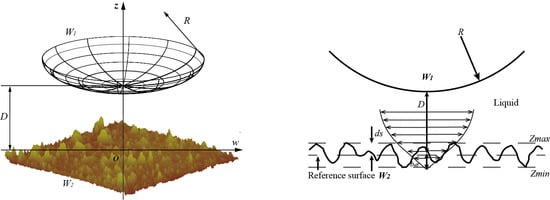Measurement and Quantification of Effective Slip Length at Solid–Liquid Interface of Roughness-Induced Surfaces with Oleophobicity
Abstract
Featured Application
Abstract
1. Introduction
2. Experiment
2.1. Measurement of Slip Length by AFM
2.2. Quantitation of Effective Slip Length on the Rough Surface
2.3. Preparation of Superoleophilic and Superoleophobic Surfaces
2.4. Characterization of Surfaces
2.4.1. Morphology of Roughness
2.4.2. CA and CAH Measurement
3. Results and Discussion
3.1. Morphology and Surface Roughness
3.2. CA and CAH
3.3. Effective Boundary Slip
3.3.1. Superoleophilic Surfaces
- Hydrodynamic forces.Figure 6a shows the measured hydrophobic forces Fhydro applied on the AFM probe approaching the superoleophilic surface immersed in hexadecane with varying Rsm roughness as a function of separation distance D. The plots of experimental data exhibit nonlinear behavior at separation distances of 0 nm to 400 nm and are indicative of a slip boundary condition. In order to obtain the slip length, the V/Fhydro applied on the AFM probe is used for superoleophilic surfaces immersed in hexadecane and ethylene glycol as a function of separation distance D, as shown in Figure 6a. In the case of hexadecane, the plots of V/Fhydro on superoleophilic surfaces exhibit linear behavior at separation distances of 0 nm to 800 nm, and show a trend of the linear parts shifting to the left with increasing Rsm from samples a1 to a5. This means that the interceptions of V/Fhydro on the horizontal ordinate shift to the left, and lead to an increasing slip length from samples a1 to a5. For ethylene glycol, the plots of V/Fhydro are similar to those of hexadecane. This means that the increasing Rsm roughness leads to a larger slip length, as shown in Figure 6b. It can be noted that the tendencies are more obvious, because the surface tension of ethylene glycol is greater than that of hexadecane.
- Slip length. Measured slip length was obtained from the hydrophobic forces according to Equation (1). Figure 7a shows the measured slip length data as a function of Rsm roughness. For samples a1 to a5, the slip length of the superoleophilic surface immersed in hexadecane and ethylene glycol increased with increasing Rsm roughness. The effective slip length was obtained according to Equation (11). Figure 7b shows the effective slip length data as a function of Rsm roughness. Results show that all of the slip lengths are negative and remain constant from samples a1 to a5 after correction by compensation f*. This means that the flow velocity at the reference surface is discontinuous due to the rough structure, and the slippage is independent of spacing roughness, where the slip length of the sphere and the location of the reference surface are taken into account.
- Discussion. It should be noted that slip boundary conditions at the reference surface are complex, as there is rough topography, and slip length at the interface of liquid, and rough superoleophilic surface is discontinuous, which should be studied by the average hydrodynamic forces detected using AFM. The effect of spacing roughness on slip length can be described by the following model, shown in Figure 8. The boundary of rough topography were replaced by a flat plane of reference surface, and the pitches were divided into square zones, where the average length of side ε was the value of Rsm roughness. We assumed that each zone was divided into two areas: (i) the no-slip area Sε, corresponding to a cross-section of the pitch of the rough surface, containing a circle of radius α centered in the origin, which is relative to the area of Sε; and (ii) the slip area, corresponding to a cross-section of the slippery part of fluid flow.
3.3.2. Superoleophobic Surfaces
- Hydrodynamic forces. The plots of measured hydrodynamic forces Fhydro between the colloidal AFM probe and the superoleophobic surfaces immersed in hexadecane and ethylene glycol, as a function of separation distance D, are shown in Figure 9. In order to obtain slip length, the V/Fhydro applied on the AFM probe is used for superoleophilic surfaces immersed in hexadecane and ethylene glycol as a function of separation distance. In the case of superoleophobic surfaces, it can be noted that the plots of V/Fhydro shift to the left with increasing Rsm from samples a1 to a5. The results are similar to those of superoleophilic surfaces. This means that the interception of V/Fhydro on the axis of separation distance shifts to the left from b1 to b5 and leads to increased slip length. The change of hydrodynamic forces Fhydro can be expressed by the varying Rq roughness of surfaces, by the effect of the morphology of surfaces on the measured hydrodynamic forces.
- Slip length. Measured slip length of the superoleophobic surface is obtained from the hydrophobic forces Fhydro and V/Fhydro according to Equation (1). Figure 10a shows the data of measured slip length as a function of Rsm roughness. With increased roughness from b1 to b5, the slip length of the superoleophilic surface in hexadecane and ethylene glycol increases with increasing Rsm roughness. Then the effective slip length is obtained according to Equation (11). Figure 10b shows the data of effective slip length as a function of Rsm roughness. The results are similar to those of the superoleophilic surface, and show that all slip lengths are negative and remain constant from b1 to b5. This also can be explained by the existence of rough topography, leading to a discontinuity of boundary slip, and the values of remain constant with varying Rsm. For the superoleophobic surfaces, the reference surface of the morphology in a Cassie regime remains an open question. Consider the case of drainage between sphere and rough surface; the reference surface should be located at the height of Rq, as in a Wenzel regime. In this paper, application in micro-/nano-fluidic channels with rough walls on both sides has been considered, so the reference surface should still be considered as Rq of the roughness profile, which leads to a discontinuity of boundary slip.
4. Conclusions
Author Contributions
Acknowledgments
Conflicts of Interest
References
- Bhushan, B. Springer Handbook of Nanotechnology, 3rd ed.; Springer: Heidelberg, Germany, 2010; pp. 1–5. ISBN 9787560339498. [Google Scholar]
- Wolynes, P.G.; Deutch, J.M. Slip boundary conditions and the hydrodynamic effect on diffusion controlled reactions. J. Chem. Phys. 1976, 65, 450–454. [Google Scholar] [CrossRef]
- Watanabe, K.; Udagawa, Y.; Udagawa, H. Drag reduction of Newtonian fluid in a circular pipe with a highly water-repellent wall. J. Fluid Mech. 1999, 381, 225–238. [Google Scholar] [CrossRef]
- Ou, J.; Perot, B.; Rothstein, J.P. Laminar drag reduction in microchannels using ultrahydrophobic surfaces. Phys. Fluids 2004, 16, 4635–4643. [Google Scholar] [CrossRef]
- Shirtcliffe, N.J.; McHale, G.; Newton, M.I.; Zhang, Y. Superhydrophobic copper tubes with possible flow enhancement and drag reduction. ACS Appl. Mater. Interfaces 2009, 1, 1316–1323. [Google Scholar] [CrossRef] [PubMed]
- Navier, C.L.M.H. Memoire Sur les Lois du Mouvement Des Fluides. Mem. Acad. R. Sci. 1823, 6, 389–440. [Google Scholar]
- Bonaccurso, E.; Kappl, M.; Butt, H.J. Hydrodynamic force measurements: Boundary slip of water on hydrophilic surfaces and electrokinetic effects. Phys. Rev. Lett. 2002, 88, 76103. [Google Scholar] [CrossRef] [PubMed]
- Cottin-Bizonne, C.; Cross, B.; Steinberger, A.; Charlaix, E. Boundary slip on smooth hydrophobic surfaces: Intrinsic effects and possible artifacts. Phys. Rev. Lett. 2005, 94, 056102. [Google Scholar] [CrossRef] [PubMed]
- Zhu, L.; Neto, C.; Attard, P. Reliable measurements of interfacial slip by colloid probe atomic force microscopy. III. Shear-rate-dependent slip. Langmuir 2012, 28, 3465–3473. [Google Scholar] [CrossRef] [PubMed]
- Pan, Y.; Bhushan, B.; Zhao, X. The study of surface wetting, nanobubbles and boundary slip with an applied voltage: A review. Beilstein J. Nanotechnol. 2014, 5, 1042–1065. [Google Scholar] [CrossRef] [PubMed]
- Vo, T.Q.; Park, B.S.; Park, C.H.; Kim, B.H. Nano-scale liquid film sheared between strong wetting surfaces: Effects of interface region on the flow. J. Mech. Sci. Technol. 2015, 29, 1681–1688. [Google Scholar] [CrossRef]
- Vo, T.Q.; Barisik, M.; Kim, B.H. Near-surface viscosity effects on capillary rise of water in nanotubes. Phys. Rev. E Stat. Nonlin. Soft Matter Phys. 2015, 92, 053009. [Google Scholar] [CrossRef] [PubMed]
- Bakli, C.; Chakraborty, S. Slippery to sticky transition of hydrophobic nanochannels. Nano Lett. 2015, 15, 7497–7502. [Google Scholar] [CrossRef] [PubMed]
- Vo, T.Q.; Kim, B. Transport phenomena of water in molecular fluidic channels. Sci. Rep. 2016, 6, 1–8. [Google Scholar] [CrossRef] [PubMed]
- Jing, D.; Pan, Y. Electroviscous effect and convective heat transfer of pressure-driven flow through microtubes with surface charge-dependent slip. Int. J. Heat Mass. Transf. 2016, 101, 648–655. [Google Scholar] [CrossRef]
- Li, Y.; Pan, Y.; Zhao, X. Boundary condition of the roughness induced superoleophilic and superoleophobic surfaces immersed in hexadecane and ethylene glycol. Beilstein J. Nanotechnol. 2017, 8, 2504–2514. [Google Scholar] [CrossRef] [PubMed]
- Di Federico, V.; Longo, S.; King, S.; Chiapponi, L.; Petrolo, D.; Ciriello, V. Gravity-driven flow of Herschel–Bulkley fluid in a fracture and in a 2D porous medium. J. Fluid Mech. 2017, 821, 59–84. [Google Scholar] [CrossRef]
- Vinogradova, O.I. Drainage of a thin liquid film confined between hydrophobic surfaces. Langmuir 1995, 11, 2213–2220. [Google Scholar] [CrossRef]
- Vinogradova, O.I.; Yakubov, G.E. Surface roughness and hydrodynamic boundary conditions. Phys. Rev. E 2006, 73, 1–4. [Google Scholar] [CrossRef] [PubMed]
- Vinogradova, O.I.; Belyaev, A.V. Wetting, roughness and flow boundary conditions. J. Phys. Condens. Matter 2011, 23, 045302. [Google Scholar] [CrossRef] [PubMed]
- Fang, A.; Mi, Y. Drainage of a thin liquid film between hydrophobic spheres: Boundary curvature effects. Langmuir 2014, 30, 83–89. [Google Scholar] [CrossRef] [PubMed]
- Zhu, Y.; Granick, S. Limits of the hydrodynamic no-slip boundary condition. Phys. Rev. Lett. 2002, 88, 106102. [Google Scholar] [CrossRef] [PubMed]
- Bonaccurso, E.; Butt, H.J.; Craig, V.S.J. Surface roughness and hydrodynamic boundary slip of a Newtonian fluid in a completely wetting system. Phys. Rev. Lett. 2003, 90, 144501. [Google Scholar] [CrossRef] [PubMed]
- Li, Y.; Bhushan, B. The effect of surface charge on the boundary slip of various oleophilic/phobic surfaces immersed in liquids. Soft Matter 2015, 11, 7680–7695. [Google Scholar] [CrossRef] [PubMed]
- Jing, D.; Bhushan, B. The coupling of surface charge and boundary slip at the solid-liquid interface and their combined effect on fluid drag: A review. J. Colloid Interface Sci. 2015, 454, 152–179. [Google Scholar] [CrossRef] [PubMed]
- Neto, C.; Craig, V.S.J.; Williams, D.R.M. Evidence of shear-dependent boundary slip in Newtonian liquids. Eur. Phys. J. E 2003, 12, 59–62. [Google Scholar] [CrossRef] [PubMed]
- Kunert, C.; Harting, J. Roughness induced boundary slip in microchannel flows. Phys. Rev. Lett. 2007, 99. [Google Scholar] [CrossRef] [PubMed]
- Cottin-Bizonne, C.; Steinberger, A.; Cross, B.; Raccurt, O.; Charlaix, E. Nanohydrodynamics: The intrinsic flow boundary condition on smooth surfaces. Langmuir 2008, 24, 1165–1172. [Google Scholar] [CrossRef] [PubMed]
- Pan, Y.; Jing, D.; Zhao, X. Effect of surface roughness on the measurement of boundary slip based on Atomic Force Microscope. Sci. Adv. Mater. 2017, 9, 122–127. [Google Scholar] [CrossRef]
- Brown, P.S.; Bhushan, B. Mechanically durable, superoleophobic coatings prepared by layer-by-layer technique for anti-smudge and oil-water separation. Sci. Rep. 2015, 5, 8701. [Google Scholar] [CrossRef] [PubMed]
- Bonnivard, M.; Dalibard, A.L.; Gérard-Varet, D. Computation of the effective slip of rough hydrophobic surfaces via homogenization. Math. Model Methods Appl. Sci. 2014, 24, 2259–2285. [Google Scholar] [CrossRef]
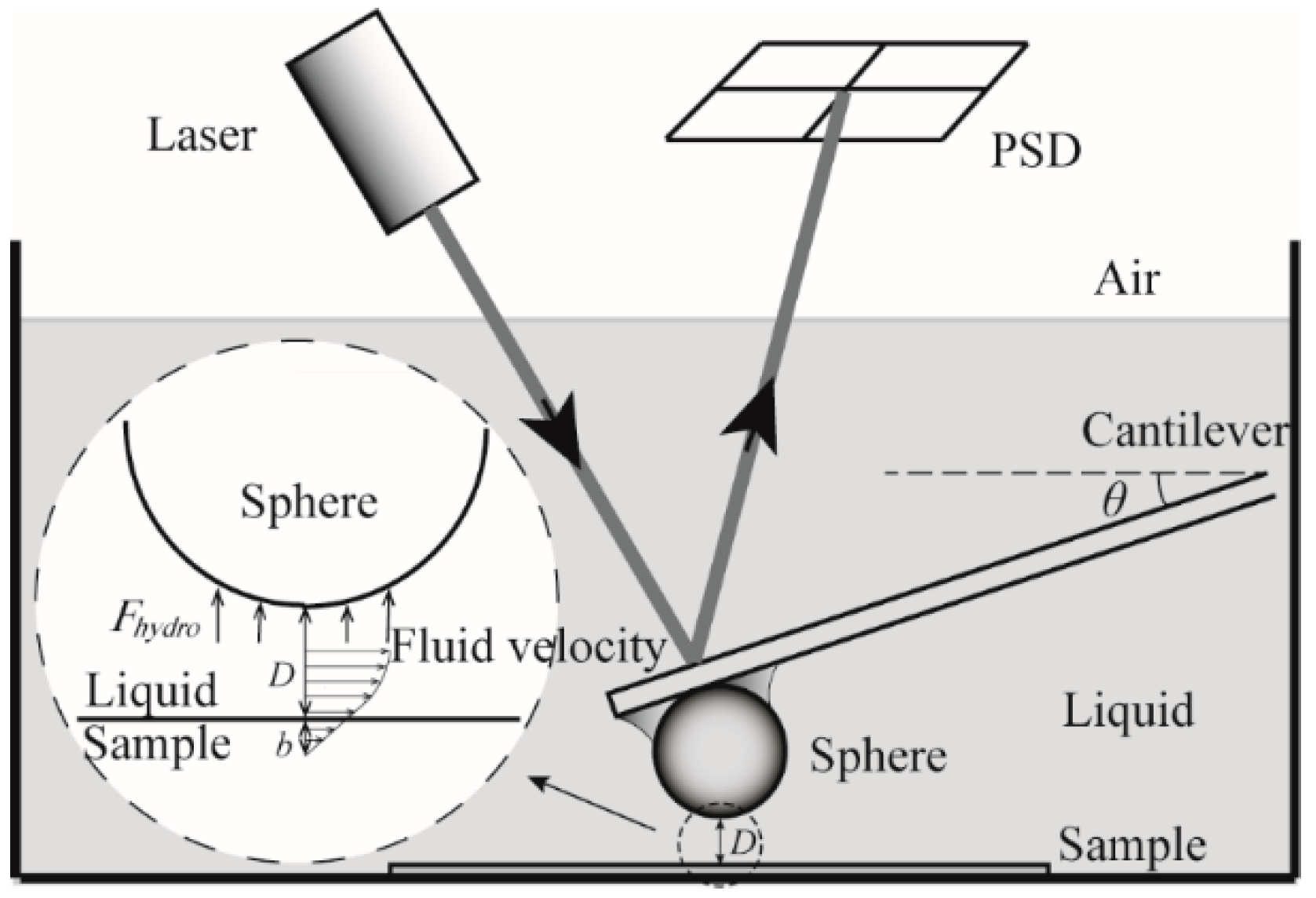
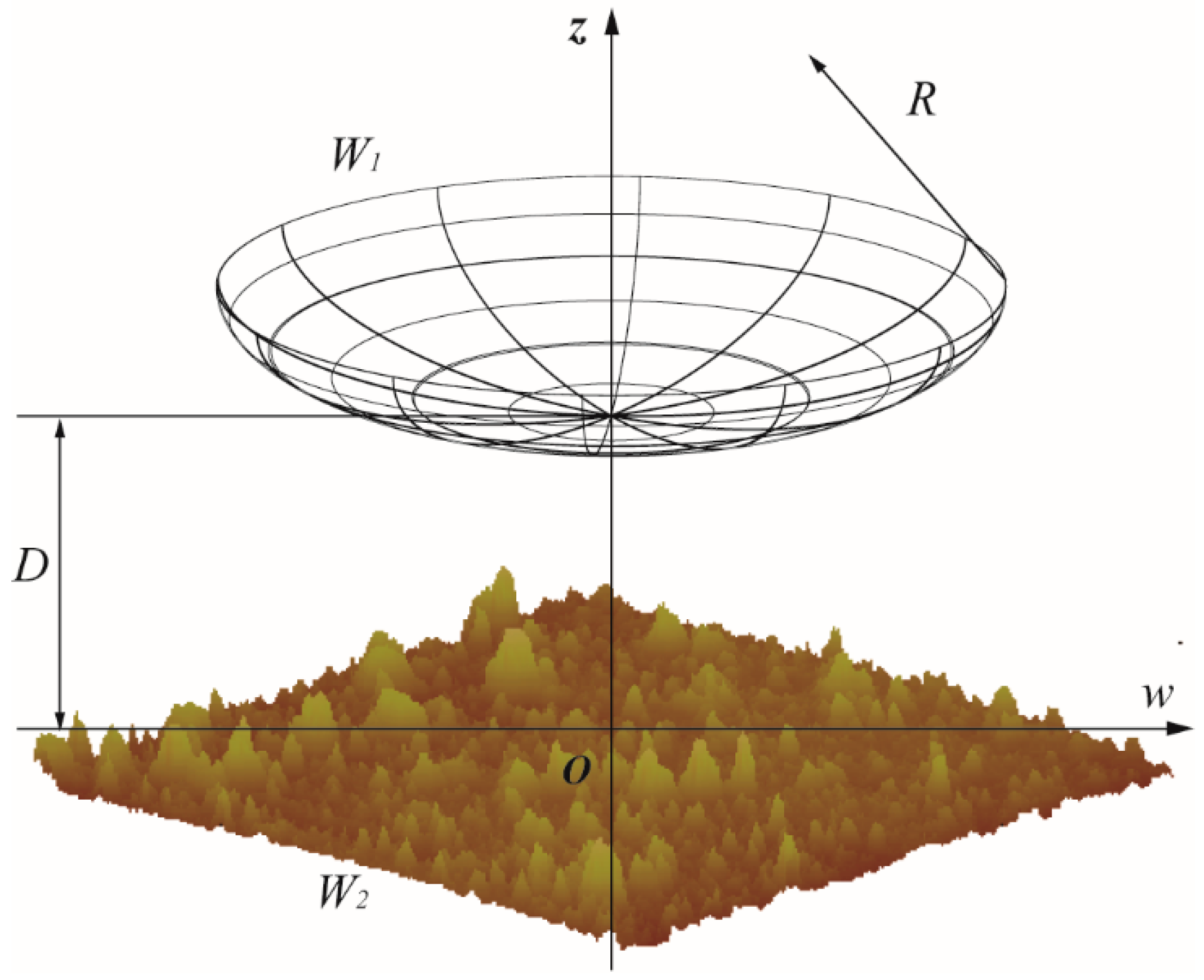
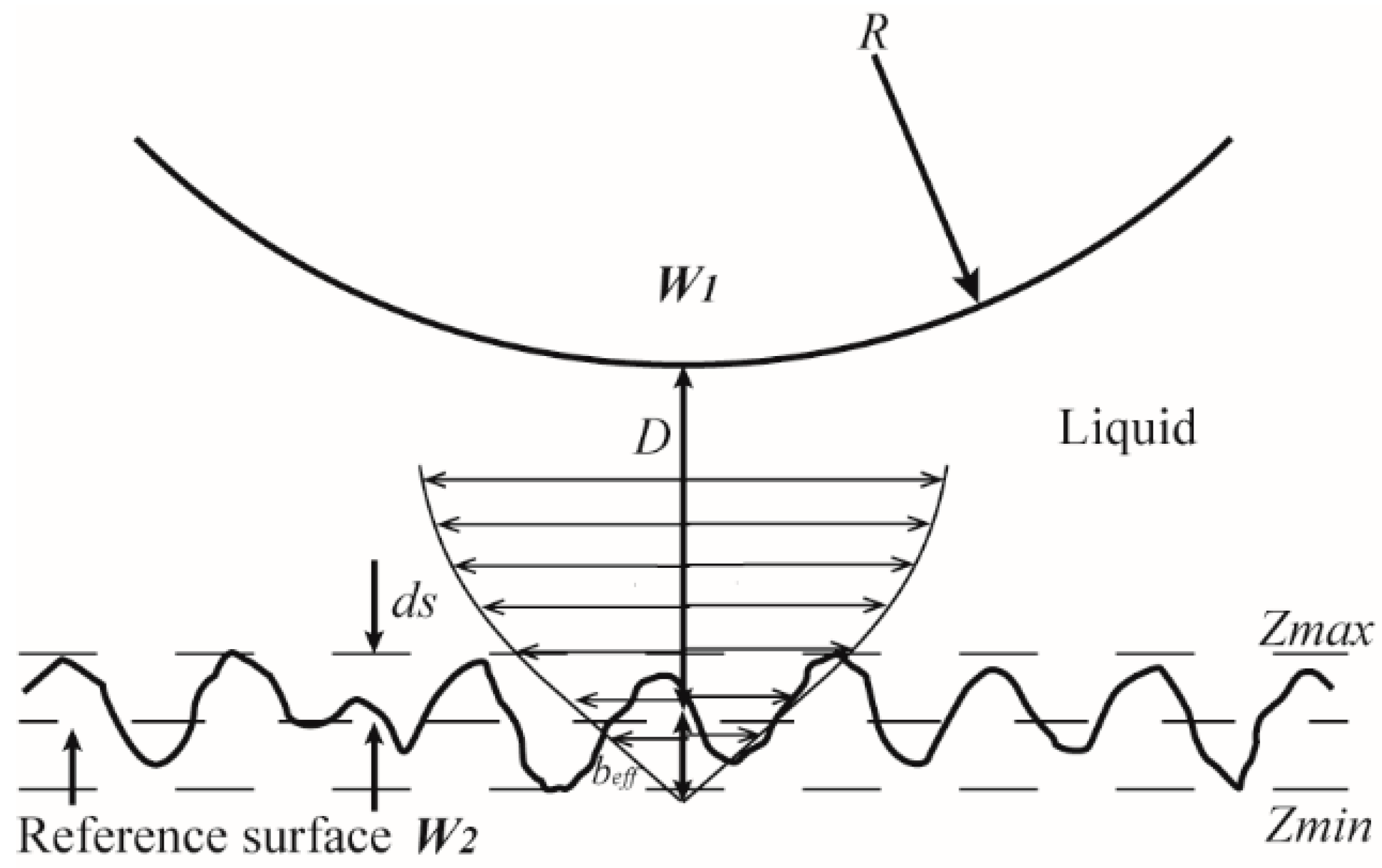
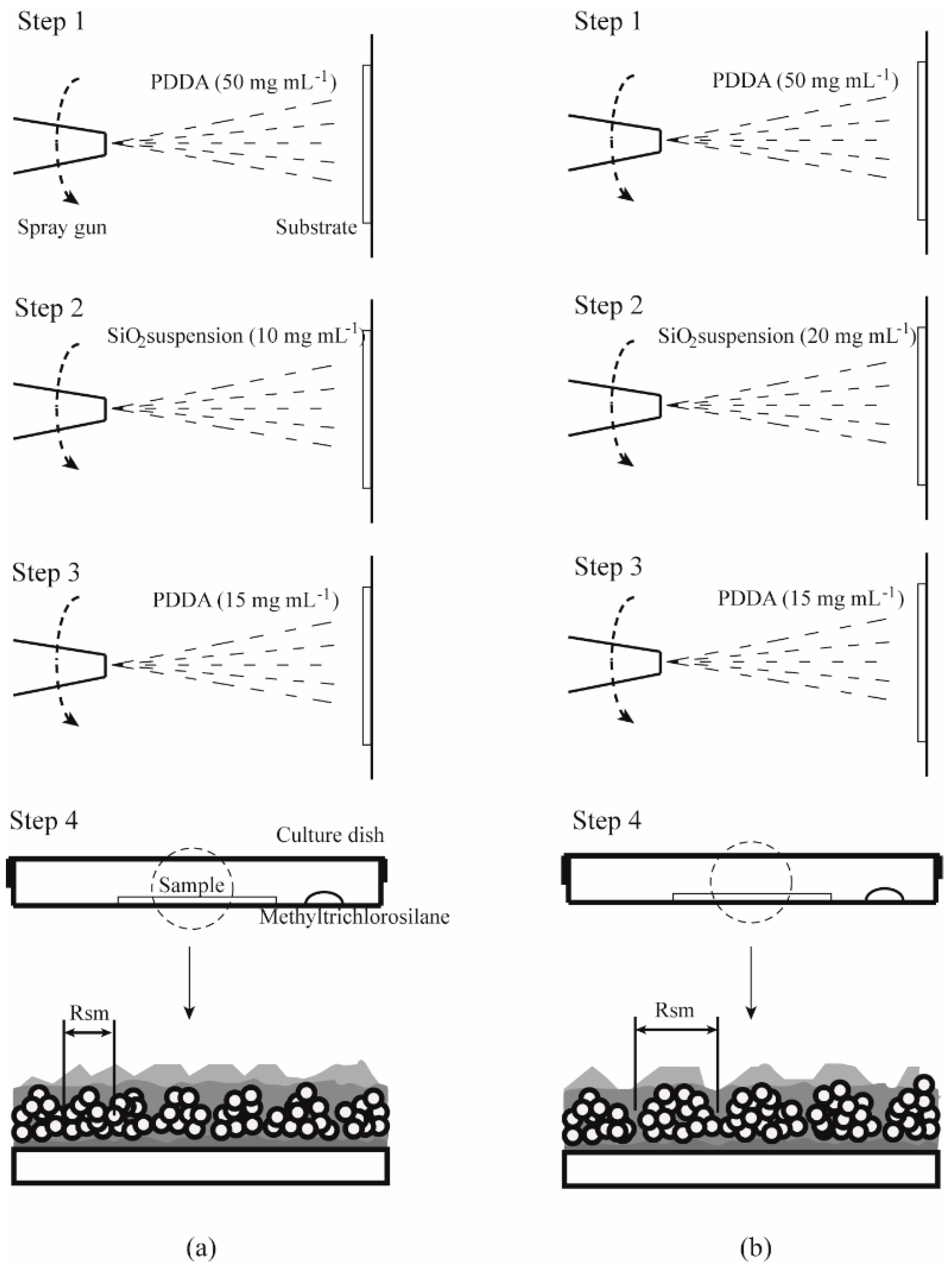
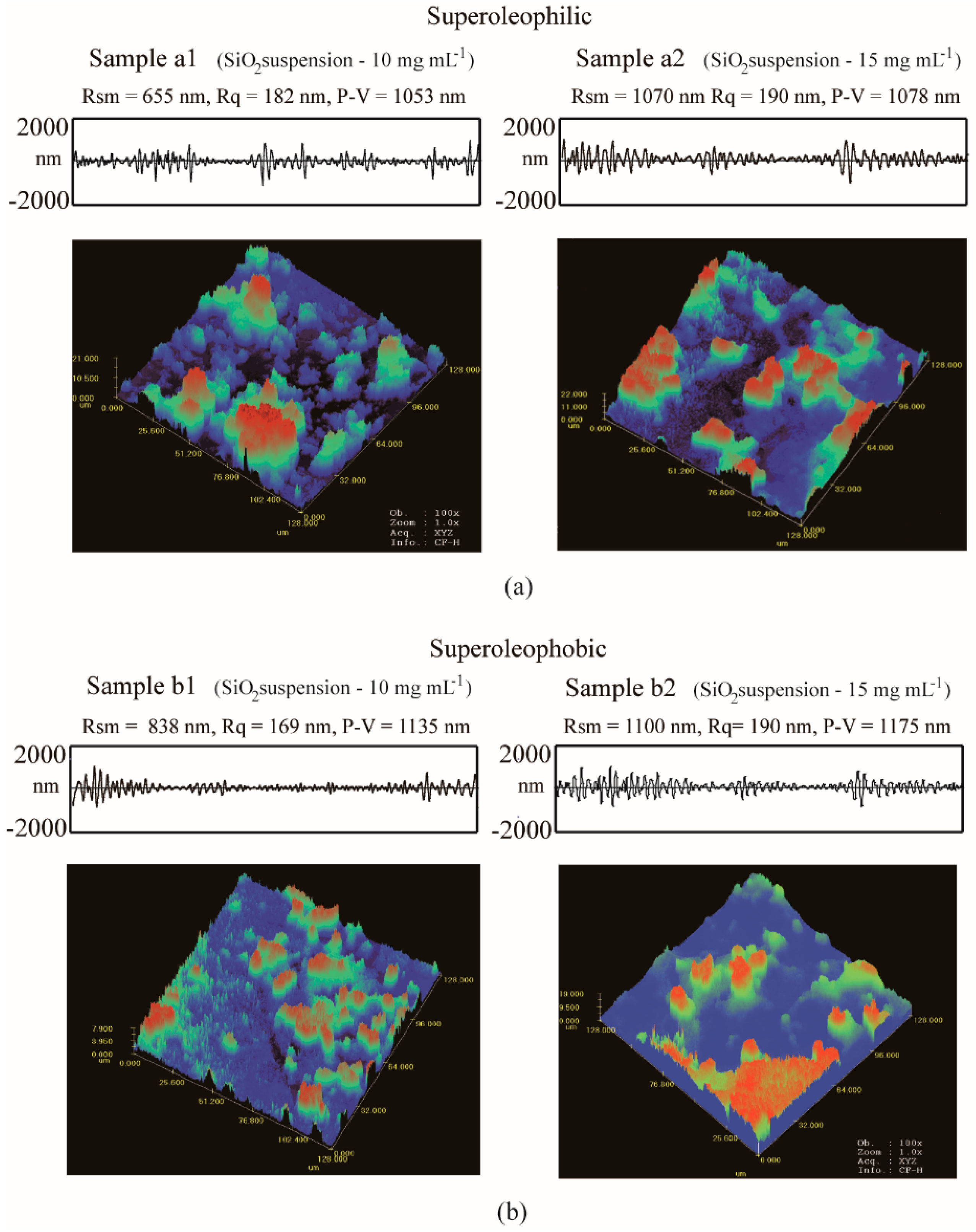
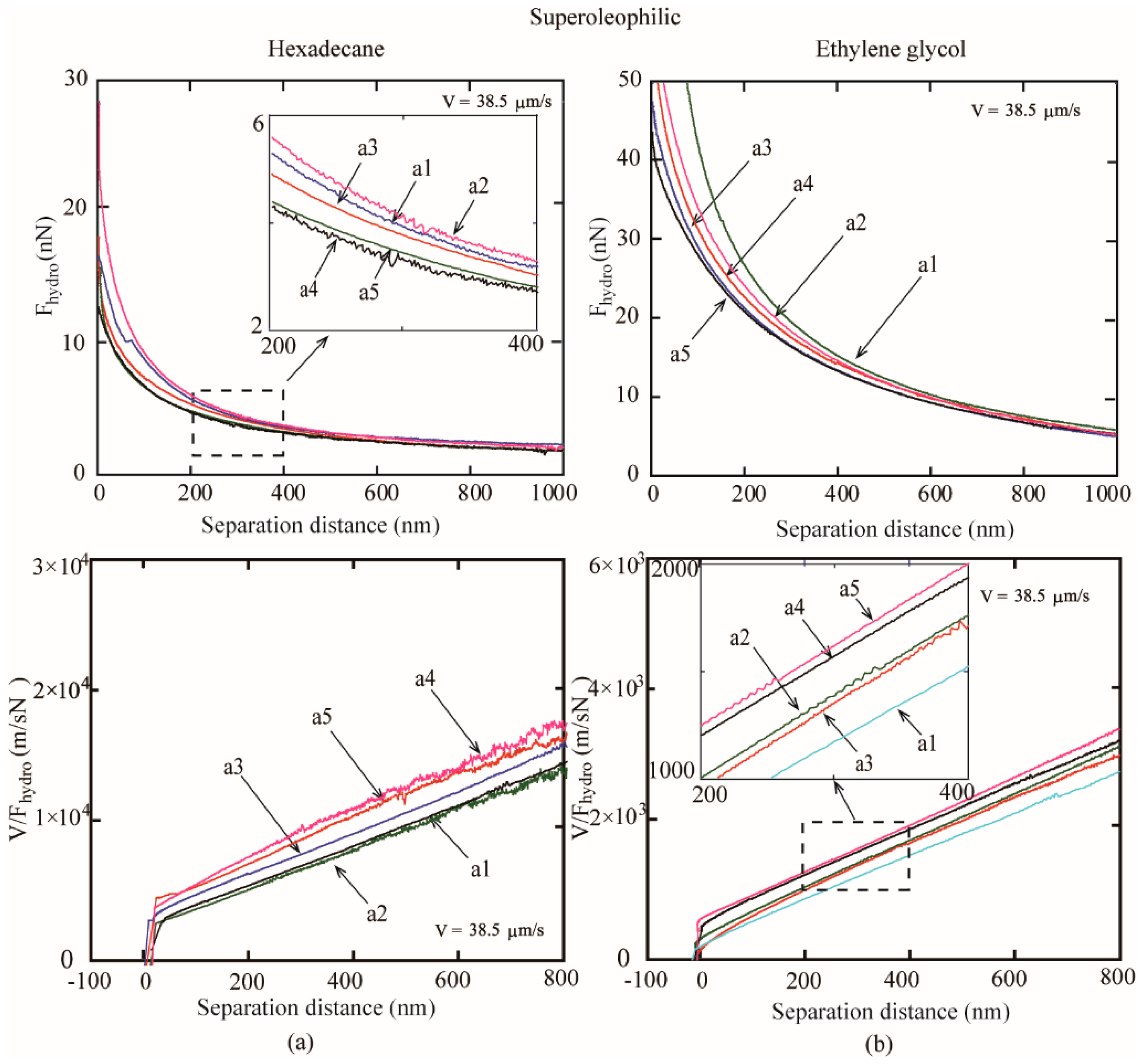
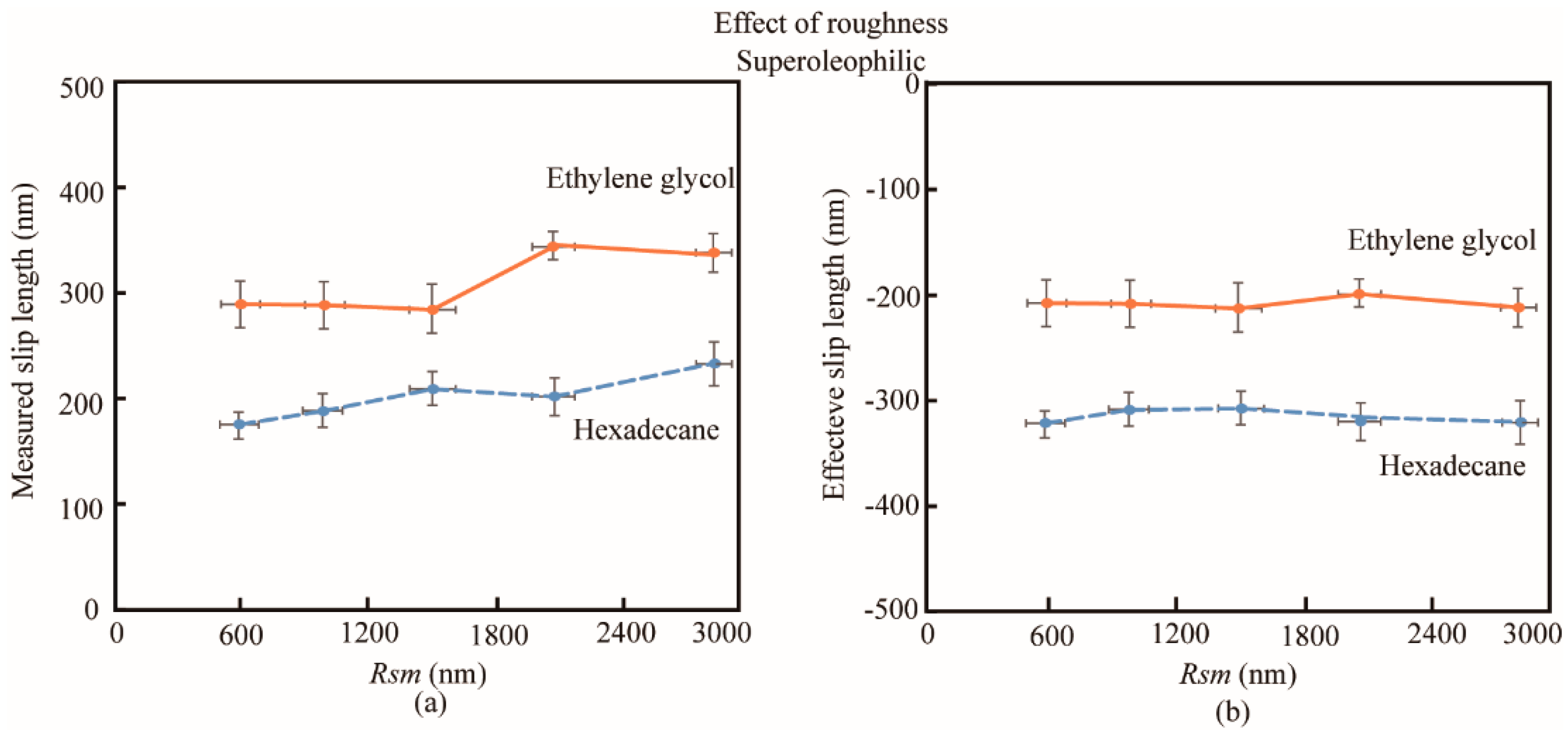
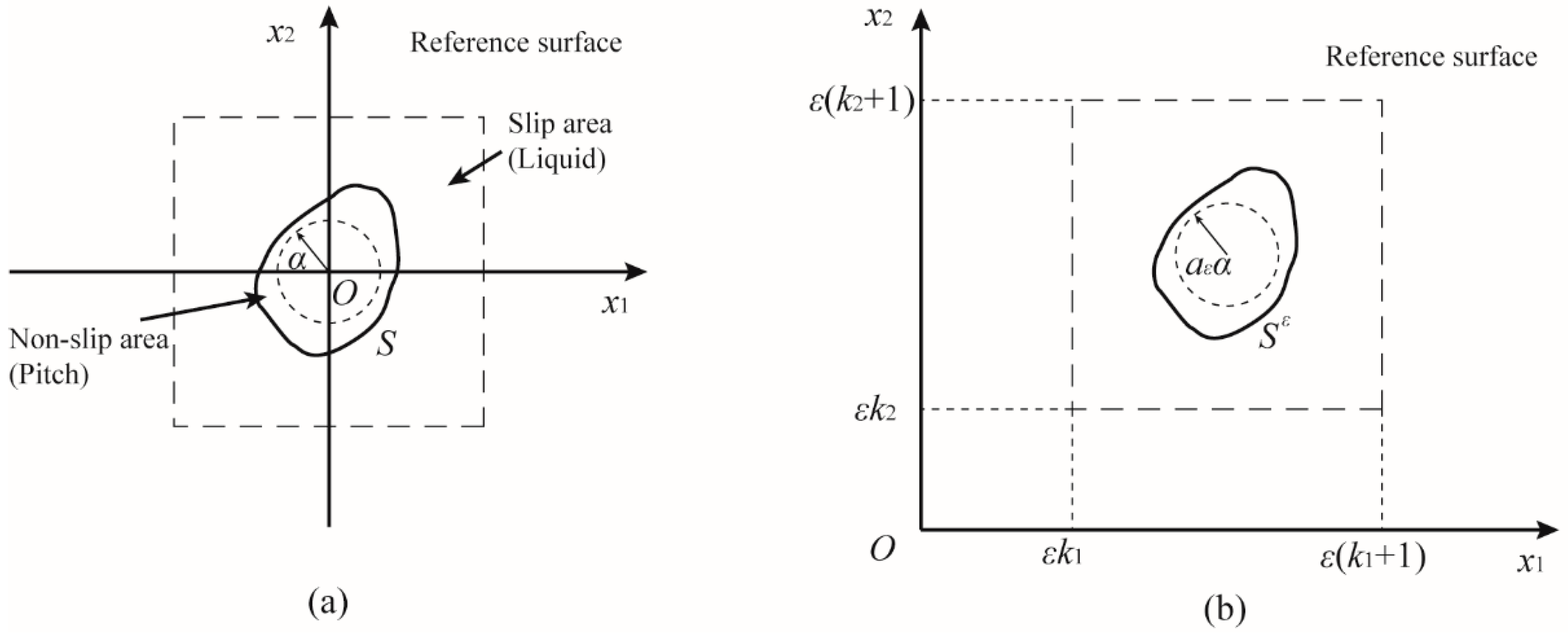
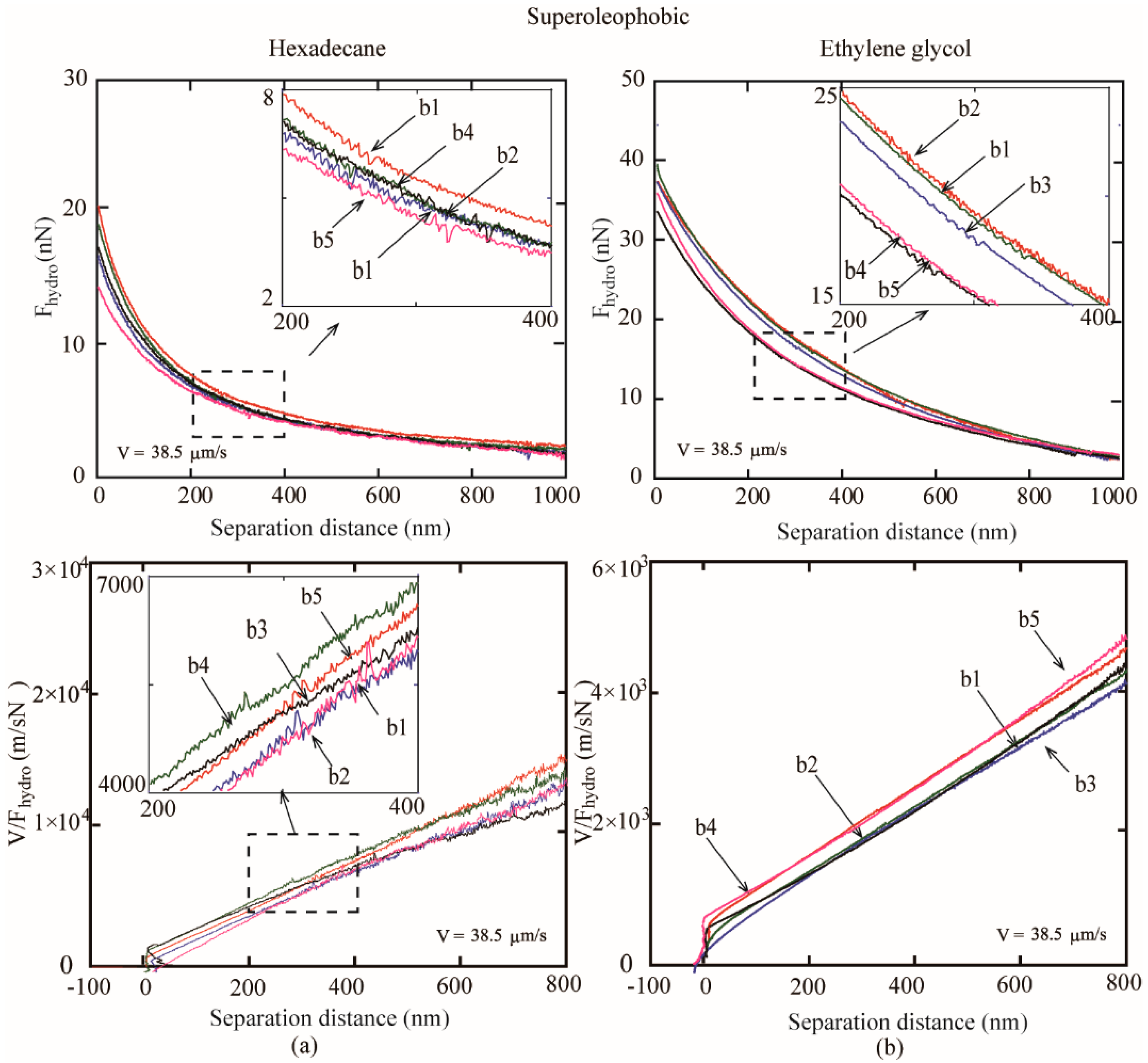
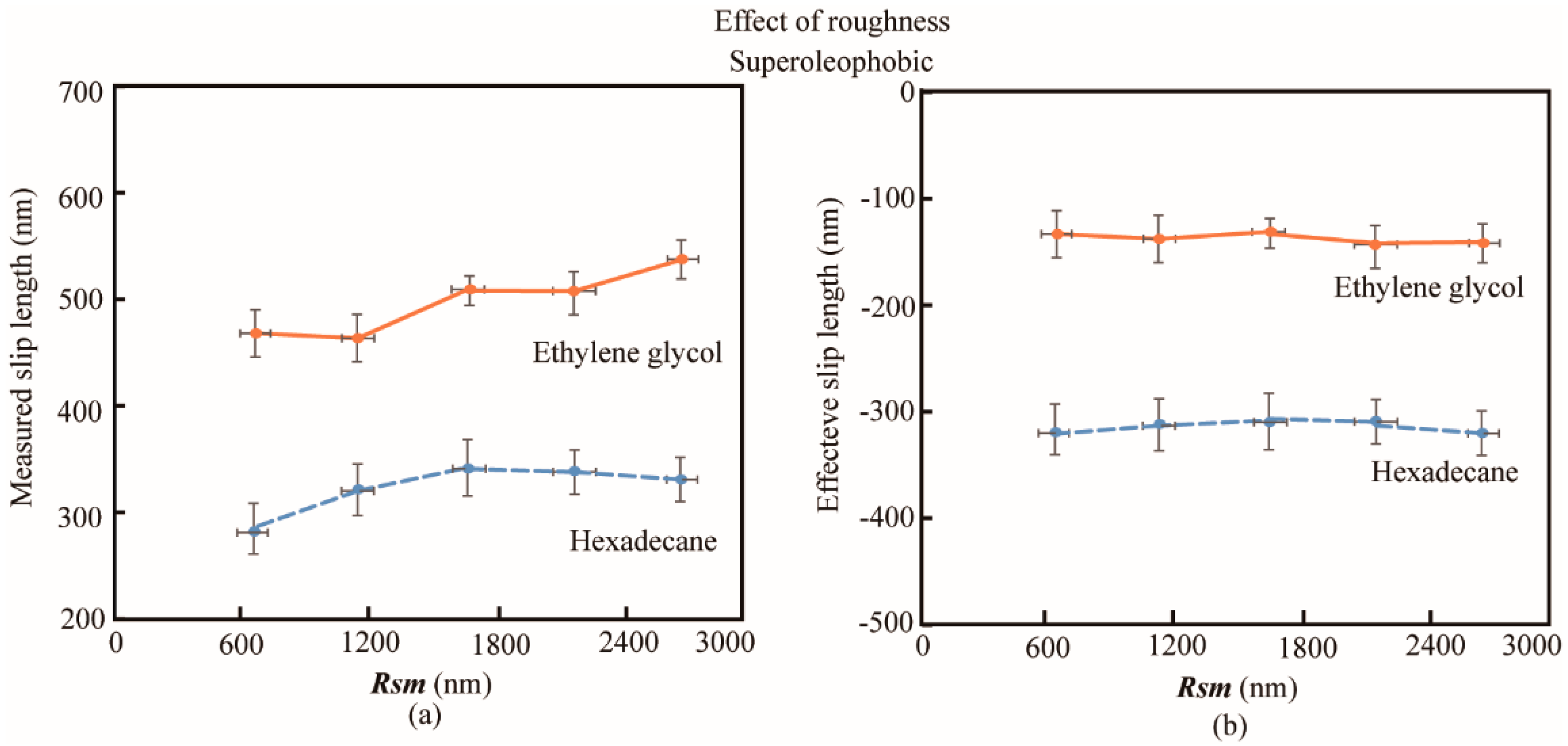
| Type | Rz (nm) | Rsm (nm) | Hexadecane | Ethylene Glycol | ||
|---|---|---|---|---|---|---|
| CA (°) | CAH (°) | CA (°) | CAH (°) | |||
| a1 | 1040 ± 150 | 620 ± 90 | 0 | – | 10 ± 1 | – |
| a2 | 1100 ± 100 | 1080 ± 100 | 0 | – | 10 ± 1 | – |
| a3 | 1160 ± 100 | 1480 ± 110 | 0 | – | 10 ± 1 | – |
| a4 | 1050 ± 80 | 2050 ± 100 | 0 | – | 10 ± 1 | – |
| a5 | 1110 ± 100 | 2740 ± 100 | 0 | – | 10 ± 1 | – |
| b1 | 1100 ± 100 | 760 ± 100 | 150 ± 3 | 10 ± 2 | 159 ± 5 | 7 ± 1 |
| b2 | 1120 ± 80 | 1170 ± 150 | 150 ± 3 | 8 ± 1 | 160 ± 3 | 5 ± 1 |
| b3 | 1150 ± 100 | 1690 ± 100 | 152 ± 2 | 6 ± 1 | 158 ± 3 | 6 ± 1 |
| b4 | 1150 ± 80 | 2050 ± 150 | 151 ± 2 | 8 ± 1 | 160 ± 3 | 5 ± 2 |
| b5 | 1180 ± 100 | 2670 ± 100 | 155 ± 3 | 8 ± 2 | 158 ± 5 | 5 ± 1 |
© 2018 by the authors. Licensee MDPI, Basel, Switzerland. This article is an open access article distributed under the terms and conditions of the Creative Commons Attribution (CC BY) license (http://creativecommons.org/licenses/by/4.0/).
Share and Cite
Li, Y.; Pan, Y.; Zhao, X. Measurement and Quantification of Effective Slip Length at Solid–Liquid Interface of Roughness-Induced Surfaces with Oleophobicity. Appl. Sci. 2018, 8, 931. https://doi.org/10.3390/app8060931
Li Y, Pan Y, Zhao X. Measurement and Quantification of Effective Slip Length at Solid–Liquid Interface of Roughness-Induced Surfaces with Oleophobicity. Applied Sciences. 2018; 8(6):931. https://doi.org/10.3390/app8060931
Chicago/Turabian StyleLi, Yifan, Yunlu Pan, and Xuezeng Zhao. 2018. "Measurement and Quantification of Effective Slip Length at Solid–Liquid Interface of Roughness-Induced Surfaces with Oleophobicity" Applied Sciences 8, no. 6: 931. https://doi.org/10.3390/app8060931
APA StyleLi, Y., Pan, Y., & Zhao, X. (2018). Measurement and Quantification of Effective Slip Length at Solid–Liquid Interface of Roughness-Induced Surfaces with Oleophobicity. Applied Sciences, 8(6), 931. https://doi.org/10.3390/app8060931




